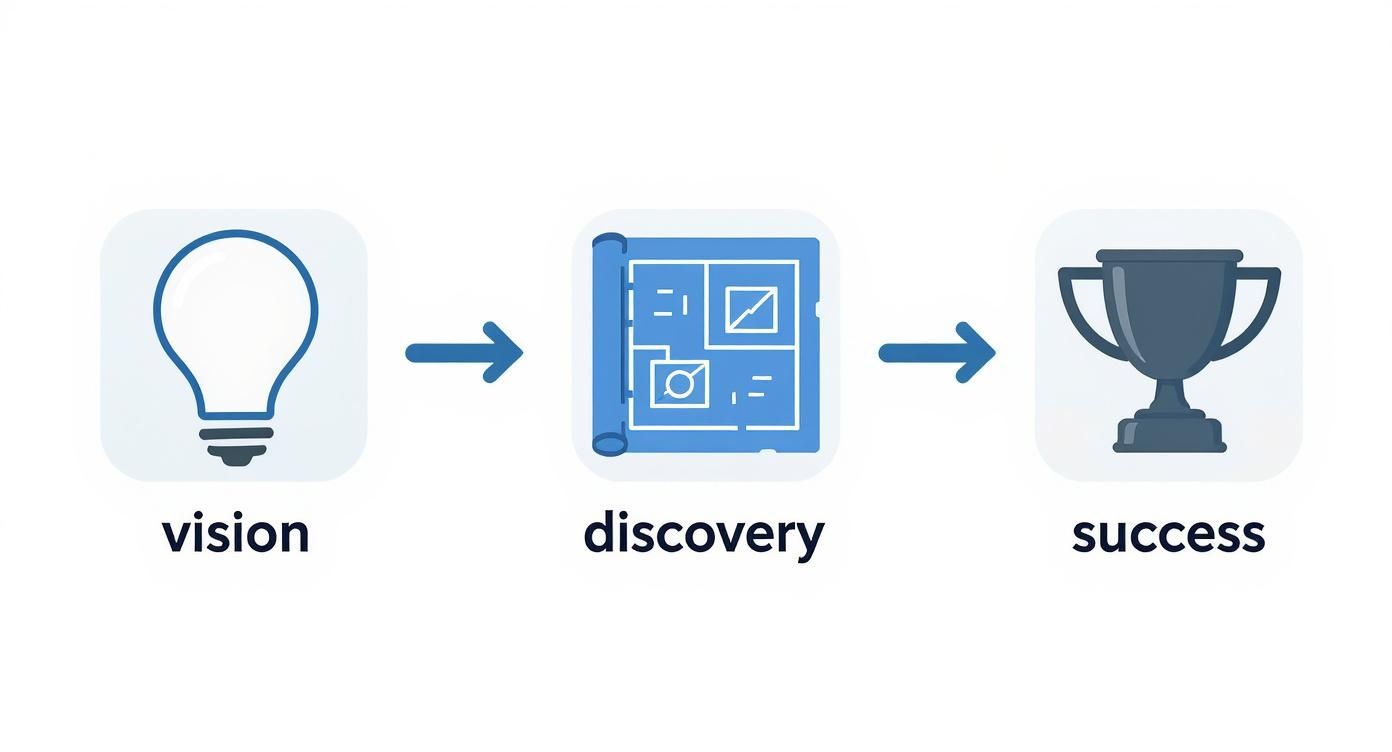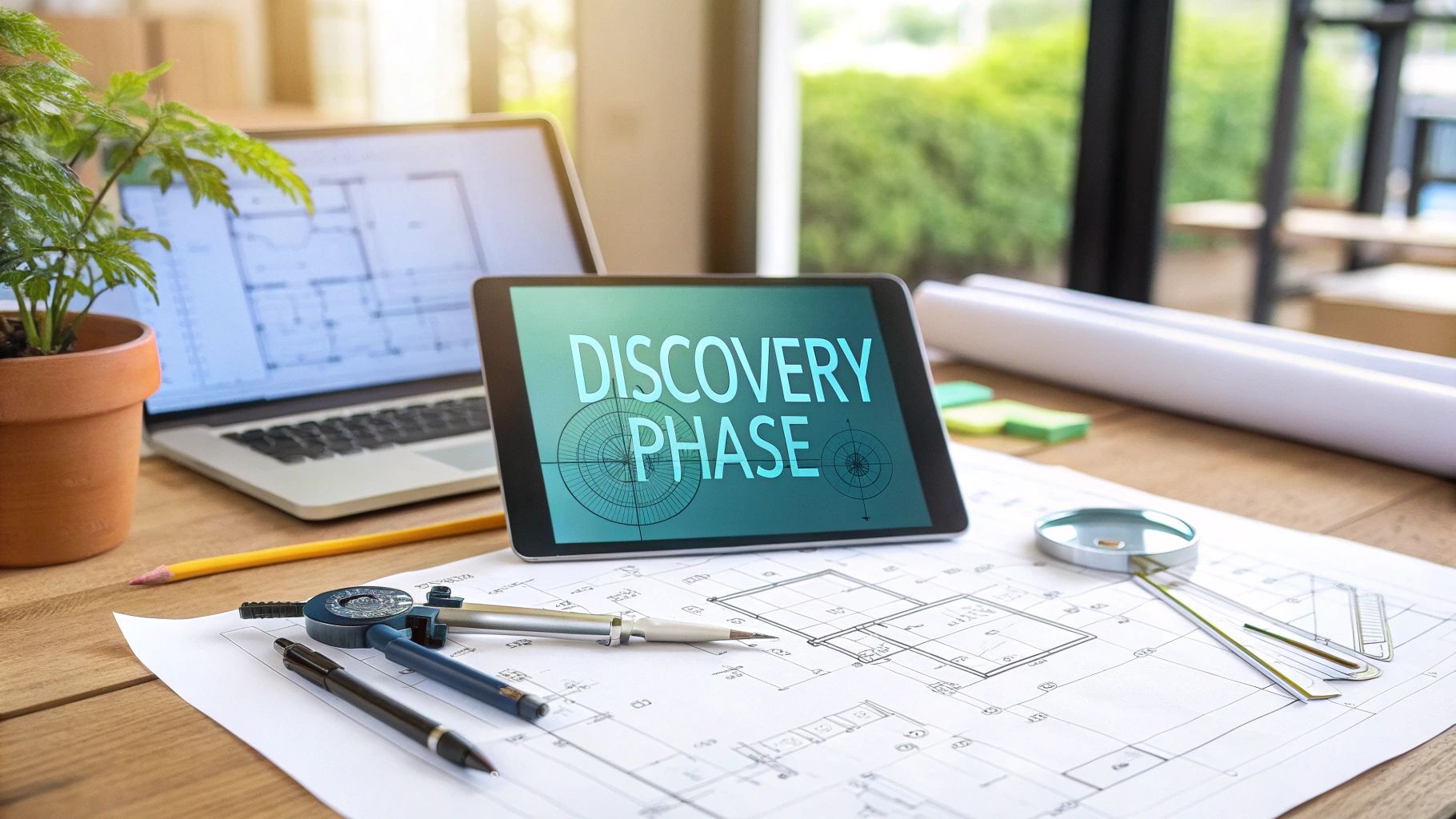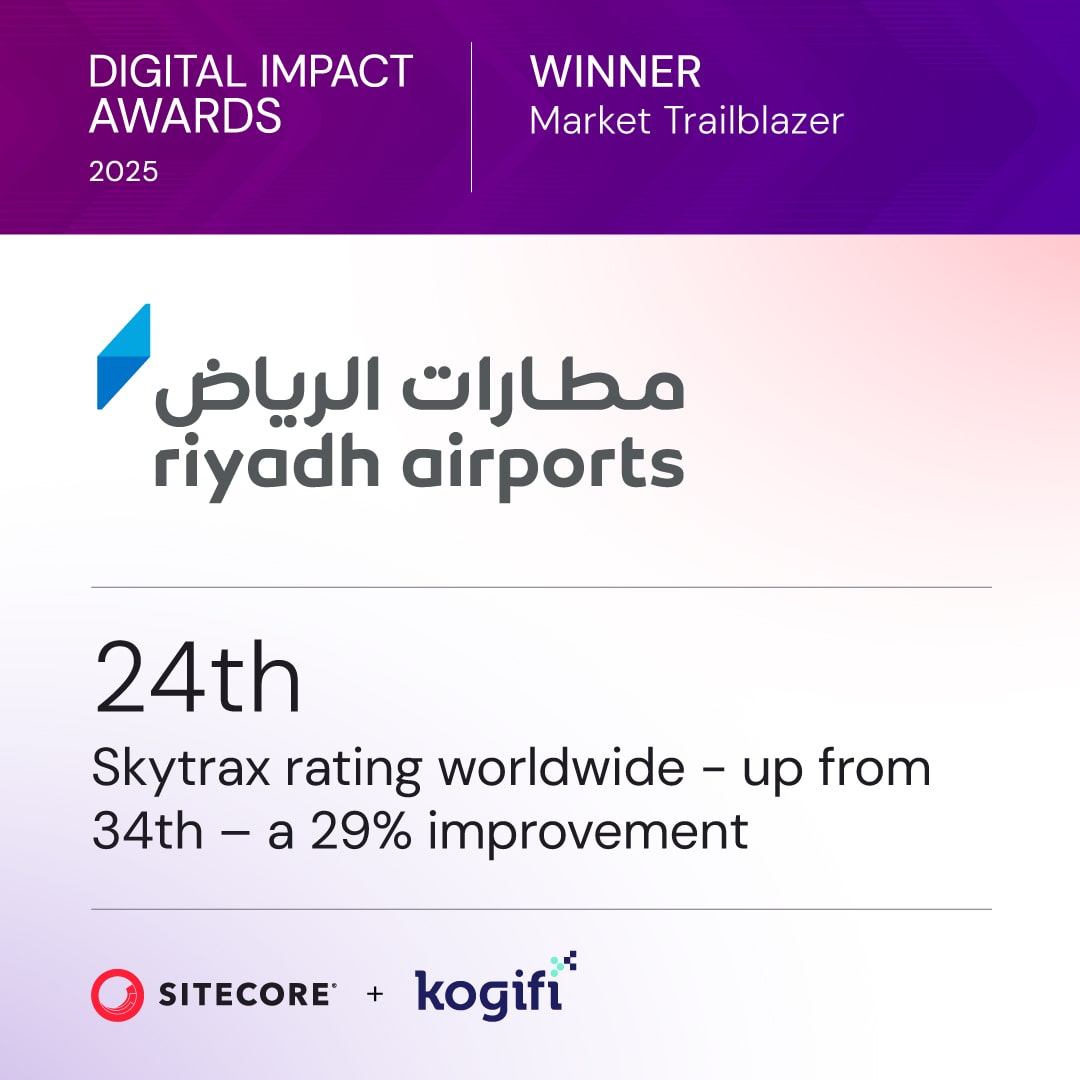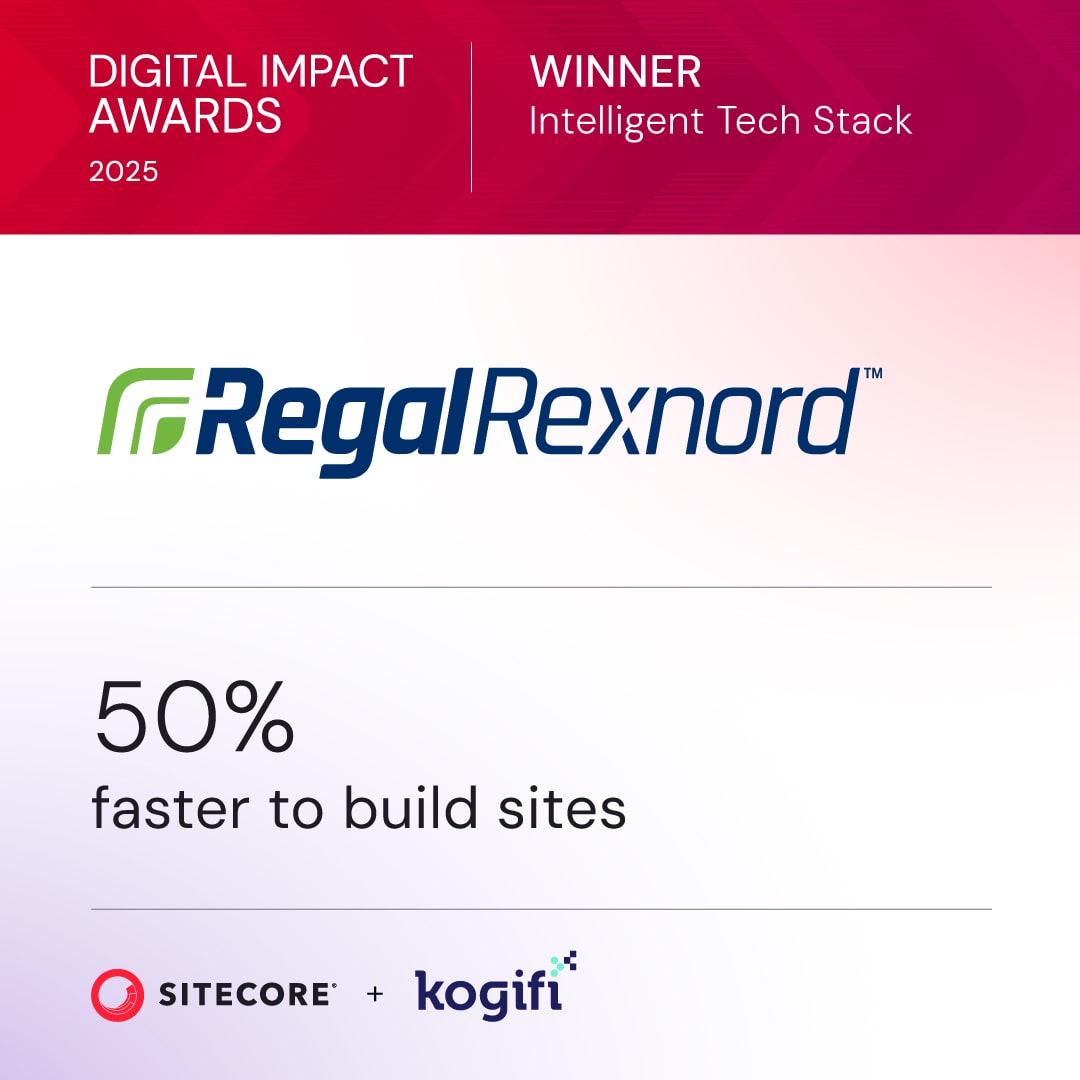Diving into a complex Sitecore or SharePoint project without a solid plan is like trying to build a skyscraper without a blueprint. It's a recipe for chaos, blown budgets, and a final product that just doesn’t hold up. The discovery phase project is that essential blueprint for your digital investment, turning a big-picture vision into a clear, actionable roadmap for your DXP or intranet.
Why A Discovery Phase Is Non-Negotiable
A proper discovery phase isn't just a "nice-to-have" first step; it's a strategic process that de-risks your entire investment in platforms like Sitecore or SharePoint. By nailing down the scope, validating technical feasibility, and identifying potential roadblocks from the get-go, this phase ensures every stakeholder is aligned. It's the most effective way to prevent the scope creep and expensive rework that so often derail major digital platform implementations.
The value of this upfront work becomes crystal clear when you look at why so many software projects go off the rails. A significant percentage of new projects either fail completely or are plagued by scope creep because the initial homework wasn't done. The discovery phase is designed to eliminate that uncertainty by setting realistic goals, timelines, and budgets before a single component is developed.
From Vision To A Viable Roadmap
Let's say you want to launch a new solution using Sitecore's composable DXP. The vision is ambitious: leverage Sitecore XM Cloud for content management, Sitecore Personalize for deep 1:1 engagement, and Sitecore Search for AI-powered discovery. A discovery phase grounds that ambition in reality.
This is where we roll up our sleeves and ask the tough questions:
- What specific business KPIs will this platform impact?
- How will we architect the content migration from a legacy system to XM Cloud?
- What is the optimal technical architecture to support the desired user experience and performance?
- Which user journeys are most critical to personalize on day one?
This detailed process ensures the solution isn't just technically sound but is laser-focused on your business objectives, whether that's increasing conversions, improving customer loyalty, or streamlining content operations.
A well-run discovery leaves no room for surprises. It replaces assumptions with data, turns ambiguity into clarity, and swaps risk for a predictable path to success. This is the foundation that every high-performing Sitecore and SharePoint solution is built on.
To give a clearer picture of what the discovery phase aims to achieve, let's break down its core goals. The table below outlines the primary objectives and their direct impact on the project's success.
Core Goals Of The Discovery Phase
Ultimately, these objectives work together to de-risk the entire project, ensuring that the final product not only meets technical requirements but also delivers tangible business value.
The Strategic Value Of Upfront Planning
At the end of the day, a discovery phase project gives you the clarity you need to make smart, informed decisions. It confirms the business case for the investment and delivers a detailed plan that developers can execute with total confidence. For a deeper dive into this, there are great insights on balancing agility and effectiveness in product discovery. This initial planning saves a massive amount of time and money down the road, making sure your digital platform delivers on its promise right from the start.
Key Activities in a Sitecore Discovery Phase
A solid Sitecore discovery phase isn't just a series of open-ended chats; it's a structured investigation into your digital ecosystem. Every activity is designed to translate high-level business goals into concrete, actionable requirements for your Sitecore implementation.
It all kicks off with intensive stakeholder workshops. We bring together key players—marketing leaders, IT architects, content authors, and business decision-makers. In these sessions, we push past vague ambitions like "improving customer experience" to define precisely what success looks like in the context of Sitecore's capabilities.
For instance, a goal to "increase engagement" becomes a specific requirement to implement Sitecore Personalize for real-time, behavior-based content targeting on critical landing pages, leveraging data from Sitecore CDP. This ensures every technical decision is directly tied to a measurable business objective.
Mapping The Technical and User Landscape
Once aligned on the goals, we conduct a comprehensive audit of your current digital setup. This technical deep-dive examines everything: existing content models, data schemas, API endpoints, and dependencies on third-party systems. This is crucial for making informed architectural decisions for a composable DXP.
The audit's findings determine whether a headless solution with Sitecore XM Cloud is the right path, or if a different Sitecore architecture is a better fit. It also highlights the specific integration points needed for tools like Sitecore Search, Sitecore OrderCloud, or Sitecore Connect, paving the way for a seamlessly integrated digital experience platform. Looking at examples, like a focused AI Discovery Workshop, shows how these structured sessions can uncover critical technical needs early on.
Simultaneously, we focus on the human side. We develop detailed user personas and map critical customer journeys. This isn't just about demographics; it's about understanding motivations, pain points, and the precise steps users take. This work becomes the bedrock of a powerful personalization strategy, dictating how, when, and where to adapt content for different audiences within Sitecore.
This flow chart really brings to life how a structured discovery turns an initial idea into a successful project, cutting out a ton of risk along the way.

As the infographic shows, jumping straight from vision to implementation is a recipe for trouble. A formal discovery phase is the essential bridge that ensures you get where you want to go.
From Insights To A Prioritized Plan
All these activities culminate in one of the most important deliverables: a prioritized product backlog. Each item in this backlog is written as a user story—a simple, plain-language description of a feature from the perspective of the person who will use it.
For example: "As a returning customer, I want to see personalized product recommendations on the homepage driven by my browsing history in Sitecore CDP, so I can find relevant items faster."
This backlog becomes the foundation for a phased implementation roadmap. The roadmap lays out a clear timeline, breaks the project into manageable sprints, and makes sure the development team tackles the highest-impact business priorities first, ensuring a rapid time-to-value.
The core purpose of these discovery activities is to remove ambiguity. By the end of this phase, we have a shared understanding among all stakeholders and a detailed, validated plan that guides the entire build.
This careful, methodical approach is a must-have for any major digital project. For any company looking to build or optimize a digital experience platform, getting the discovery process right is the first step toward a successful launch. You can learn more about our approach to building powerful digital experiences with Sitecore and see how we put these principles into practice. Every activity is a deliberate step toward building a digital platform that’s robust, scalable, and ready to perform.
Essential Deliverables That Guide Your Project

All the brainstorming and workshop sessions eventually need to become something tangible. That's where the deliverables of a discovery phase project come in. These aren't just documents for the sake of paperwork; they are the alignment tools that turn abstract ideas into a concrete plan.
Think of them as the single source of truth for the entire project. They get everyone—from business stakeholders to the technical teams—looking at the same map and heading in the same direction. Each deliverable serves a unique purpose, methodically moving the project from a high-level concept to a build-ready specification.
The Solution Design Document
The Solution Design Document (SDD) is the developer's bible for any Sitecore or SharePoint project. It's the highly detailed document that translates all the business needs and user requirements we uncovered into a technical blueprint. For a Sitecore XM Cloud implementation, the SDD will specify everything from the headless component architecture and content schemas to the precise integration patterns with Sitecore Personalize, Sitecore CDP, or other third-party systems via Sitecore Connect.
The SDD eliminates guesswork. It clearly outlines the technical approach, data models, and specific configurations, giving the development team everything they need before a single line of code is written.
Wireframes and Technical Diagrams
While the SDD explains how the system works, wireframes show stakeholders what it will look like and how users will interact with it. These are low-fidelity visual guides that map out the user interface and critical user flows. They focus purely on structure and function, letting everyone validate the user experience without getting sidetracked by colors or branding.
For a complex platform like a new SharePoint intranet, wireframes are absolutely vital for designing navigation that actually makes sense. Getting the user experience right at this stage is crucial. If you want to dig deeper, our user experience audit checklist is a great resource.
Working alongside the wireframes are technical architecture diagrams. These are the high-level visuals that show how all the pieces of the puzzle—the CMS, APIs, third-party services like Sitecore Search, and cloud environments—fit together.
A great discovery phase concludes with a validated project backlog and a development plan grounded in verified assumptions. This means having a prioritized list of user stories, a cost forecast approved by finance, and clear success criteria. Learn more about how a detailed discovery sets the stage for a successful software project.
Backlog and Implementation Roadmap
Finally, all the features, functions, and requirements are broken down into a prioritized product backlog. Each item in the backlog is written as an actionable user story, representing a small, valuable slice of functionality that the development team can build.
This backlog is the engine that drives development.
The prioritized list feeds directly into the implementation roadmap, which is a high-level timeline showing the build schedule, key milestones, and release dates. It gives everyone a clear, transparent view of the project's path forward, ensuring there are no surprises when it comes to progress, timelines, or budget.
Adapting Discovery for SharePoint Solutions
While the core principles of discovery are universal, applying them to SharePoint requires a distinct focus. Unlike public-facing DXP projects, SharePoint is all about what happens inside an organization—internal collaboration, document management, and business process automation.
This means the entire discovery process shifts inward. We’re not mapping customer journeys; we’re mapping employee workflows. The goal is to build a modern intranet, document hub, or collaborative workspace that your employees will actually want to use. That requires a deep dive into the specific, often complex, collaborative processes that keep your business running.
Mapping Internal Workflows and Content
Our first job is to understand how your organization is structured and how information moves through it. This goes way beyond just mapping out a sitemap. We’re untangling the intricate web of departmental processes, communication channels, and content lifecycles.
To do this right, we focus on a few key activities tailored for the SharePoint environment:
- Content and Information Audits: We meticulously review your existing file shares, legacy intranets, and content repositories to design a logical, intuitive information architecture. This is crucial for preventing the common SharePoint pitfall of becoming a digital dumping ground.
- Departmental Interviews: Getting in the trenches with individual departments is non-negotiable. These interviews help us map out how teams really work together, identifying the pain points and bottlenecks that a new SharePoint solution can solve.
- Microsoft 365 Tenant Assessment: We conduct a technical review of your existing Microsoft 365 setup to ensure the new solution will integrate seamlessly and leverage the full power of the ecosystem, including Teams, Power Platform, and OneDrive.
This deep dive is what allows us to build custom SharePoint solutions that feel like a streamlined asset, not another corporate headache.
A SharePoint discovery is less about attracting customers and more about empowering employees. The primary measure of success is user adoption, which can only be achieved by designing a system that makes their daily work easier and more efficient.
Governance and Permissions From Day One
Here’s the most critical piece of the SharePoint discovery puzzle: a rock-solid governance plan and permissions model, established from the very beginning. This isn't just a "nice-to-have"; it's the foundation for long-term success and manageability.
Without clear rules on who can create sites, who can edit content, and who can access sensitive information, even the most beautifully designed intranet will spiral into chaos.
We focus on defining a clear permissions strategy that strikes the right balance between accessibility and security. This means designing user groups, setting access levels for different content types, and assigning clear ownership for every site and library. Getting this right is the single most important step in making sure your SharePoint environment stays organized, secure, and valuable for years to come.
Managing Budgets and Timelines in Discovery
Let's get right to it. The two questions every stakeholder wants answered are: How much is this going to cost, and how long will it take? It’s tempting to see a discovery phase as just another line item, but it's really an investment in making the entire project predictable and, ultimately, more cost-effective.
Think of it as spending a little now to save a lot later. This upfront work is the single best way to kick off a complex Sitecore or SharePoint implementation. It’s designed to prevent those nasty mid-project surprises and scope changes that blow up budgets and push deadlines.
Budgeting for a Successful Discovery
As a general rule, a discovery phase budget usually lands somewhere between 5-10% of the total estimated project cost. That figure isn’t pulled out of thin air; it’s directly tied to the project's complexity and risk. A large-scale Sitecore XM Cloud migration with multiple integrations into systems like Sitecore CDP and OrderCloud will naturally require a more significant discovery investment.
This budget is carefully structured to pack in as much value as possible. It covers the focused time of key experts—your solution architects, business analysts, and UX designers. They’re the ones running workshops, digging into your technical setup, and turning a vague idea into a concrete, buildable plan.
The financial argument for discovery is incredibly solid. Many IT projects run over budget and miss deadlines. A discovery phase tackles these risks head-on by locking down requirements and scope early, which means no costly curveballs down the road.
A Typical Discovery Phase Timeline
While every project is different, a standard discovery timeline for a new SharePoint intranet or Sitecore build typically takes between four to eight weeks. This isn't a rushed process. It's a deliberately paced timeline that gives us enough room to move from initial conversations to a final, actionable roadmap.
Here’s a general idea of how that time is spent:
- Weeks 1-2: Kick-off and Stakeholder Workshops. We start by getting all the key decision-makers in a room (virtual or otherwise) to align on goals and hash out the core business requirements.
- Weeks 3-4: Technical Audits and User Research. This is where our team gets their hands dirty, diving into your current systems. We also map out user journeys and pinpoint pain points. This is a great time to think about resource allocation vs team coordination in migration to ensure a smooth transition later.
- Weeks 5-6: Solution Design and Wireframing. We start turning all our findings into something tangible. This means creating architectural diagrams for the Sitecore or SharePoint solution and low-fidelity wireframes that bring the user experience to life.
- Weeks 7-8: Finalizing Deliverables and Roadmap Presentation. In the home stretch, we focus on documenting the complete solution design, building out the prioritized backlog, and presenting a clear implementation roadmap that everyone can get behind.
This structured timeline ensures that by the end of the discovery, every stakeholder has a crystal-clear understanding of the project's scope, cost, and path forward, setting the stage for a predictable and successful development phase.
Common Questions About Discovery Phase Projects
Even after getting the big picture, practical questions always come up about what a discovery phase project really looks like day-to-day. We get it. So, we've put together some straight answers to the questions we hear most often, helping clarify the investment and why this foundational work is so incredibly valuable.
These questions tackle the real-world logistics of running a discovery for complex platforms like Sitecore and SharePoint.
How Long Does a Typical Discovery Phase Last?
The timeline is always tied to the project's complexity, but most standard Sitecore or SharePoint implementations fall into a 4 to 8-week timeframe. This gives us enough runway for in-depth stakeholder interviews, a thorough technical audit, user research, and a detailed solution design.
For something smaller, like adding a single new feature, we might wrap it up in 2-4 weeks. On the flip side, a massive enterprise transformation—like a global Sitecore XM Cloud migration with numerous integrations—could easily go beyond 8 weeks to ensure every requirement and dependency is meticulously mapped.
Who Needs to Be Involved From Our Team?
A successful discovery is a team sport, and getting a complete picture depends entirely on collaboration. Your team's input is non-negotiable.
We’ll need to hear from a few key groups:
- Business Stakeholders: Leaders from marketing, sales, and operations who can define the business goals and KPIs.
- Executive Sponsors: The decision-makers who own the project's vision and can champion it across the company.
- Subject Matter Experts: The end-users and content authors who know the day-to-day operational details and user needs.
- IT Representatives: Your technical architects and engineers who understand existing systems, security policies, and integration points.
On our side, you'll work with a Project Manager, Business Analyst, Solution Architect, and UX/UI Designer. They'll guide the whole process, making sure business goals, user needs, and technical realities all line up perfectly.
What Happens if We Decide to Skip Discovery?
Let's be blunt: skipping the discovery phase is the single biggest risk you can take on a software project. It's a direct path to uncontrolled scope creep, budget overruns from endless rework, and blown deadlines as nasty surprises pop up mid-development.
More importantly, the final product might completely miss the mark on core business objectives or user needs. This often leads to low user adoption within SharePoint or poor ROI from a Sitecore investment. Discovery isn't a "nice-to-have"—it's an essential investment in getting the project right the first time.
Is a Discovery Phase Only for Brand New Projects?
Not at all. While discovery is absolutely critical for new builds, it's just as valuable for a whole range of other projects.
Consider running a discovery for:
- Major platform migrations, such as moving from a legacy CMS to Sitecore XM Cloud.
- A significant redesign of an existing website or SharePoint intranet.
- Adding complex new capabilities, like integrating Sitecore Personalize or Sitecore OrderCloud.
- Integrating new enterprise systems, like a CRM or ERP, into your digital platform.
Basically, any project with high complexity, a big budget, or a lot of stakeholders will benefit immensely from a formal discovery. It's the best way to ensure everyone is on the same page and the path to success is clear before the first line of code is written.
At Kogifi, we specialize in turning your business vision into a detailed, actionable plan through a meticulous discovery phase. Our deep expertise in Sitecore and SharePoint ensures your project starts on solid ground, de-risking your investment and setting you up for a successful outcome. Learn more about how we can guide your next digital project at https://www.kogifi.com.








































